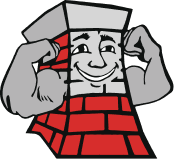Chimney Liners Are All About Safety

A new chimney liner always comes with the peace of mind that you can now safely build a fire in your fireplace.
During your annual fireplace and chimney inspection, your professional chimney sweep may advise you that a chimney liner is needed, before using the fireplace any further. Making an unexpected investment in home improvement is never the kind of news a homeowner wants to hear. But the circumstances which call for a new chimney liner mean that a house fire is possible, without the addition of a liner.
There are several situations which indicate that a chimney liner is needed, and it would be risky to ignore any of them.
The Liner is Damaged
The pumice or clay tile chimney liners which are originally built into a chimney can become damaged. When a house settles, cracks in the liner can occur. Excessively hot chimney fires can also cause a crack in the liner. Once the flue liner is cracked, the home is as vulnerable to a house fire as if there weren’t a liner.
No Chimney Lining
Chimney liners weren’t always requirements; and if you live in an old home, it’s possible that the masonry chimney has no pumice or clay tile lining. Exhaust from your fireplace tends to leak into the house through mortar joints, if there isn’t a chimney liner. A variety of health problems can result from leaks because of fine particulate matter, carbon monoxide, formaldehyde, and irritant gases which can scar the lungs.
Creosote in liquid form can also permeate the joints, in the absence of a liner. The result can be that the chimney itself can go up in flames.
Another good thing about chimney liners besides the safety they provide is that they can add longevity to the chimney structure.
New Heating Unit
Sometimes a chimney liner is required when you install a wood stove or a fireplace insert, in order for venting to work properly.
Some of the problems caused by an over-sized flue are:
• A large amount of smoke could spill into the home when the heating unit is cold.
• The stove can over fire, once it does heat up.
• Excessive formation of creosote can be the result of an oversized flue, which means that your home is at a greater risk for a chimney fire.
A chimney flue cannot be more than three times the cross-sectional area (CSA) of a stove’s flue collar, according to code requirements.
Dispel the Mystery
Address any doubts that you have about the condition of your liner, keeping in mind that any existing cracks are reason enough to require a new one. Your chimney professional should be able to show you the condition of your chimney’s interior. But if you’ve seen crumbled clay in your fireplace, you’ve seen the evidence of a damaged liner.
If you’ve installed a new heating unit, the instructions will provide the proof you need that the chimney liner must be a certain fit to the appliance. It’s possible your current liner is too big for the appliance you’re attaching to it.
Your existing chimney masonry tiles may need to be removed before a new insulated chimney liner can be installed. Ask all the questions you need to ask, to gain full confidence about what’s needed to make your chimney safe.
Once your new chimney liner is installed by a professional chimney sweep and you know you can heat your home safely, you and your family can enjoy your wood stove or fireplace with peace of mind.
Northeastern Chimney, Inc
37 Cody Street, West Hartford, CT 06110
Phone: 860-233-5770



